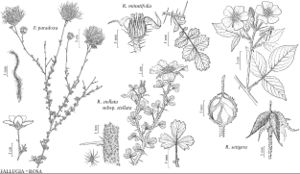Fallugia
Gen. Pl. 16: 1246. 1840.
| Taxon | Illustrator ⠉ | |
|---|---|---|
 | Fallugia paradoxa Rosa minutifolia Rosa stellata subsp. stellata Rosa setigera | Marjorie C. Leggitt John Myers John Myers John Myers |
Shrubs, 10–20 (–35) dm, polygamodioecious; rhizomatous in sandy soil. Stems 1–20+, spreading-ascending; bark brown, with age separating in papery sheets; long and short-shoots present; young stems whitish, hirtellous to villous, also stellate-lepidote with white to rust orange trichomes. Leaves deciduous, cauline, abscising distal to persistent, clasping bases, crowded on short-shoots, simple; stipules adnate, acicular, reduced on short-shoot leaves, margins entire; petiole present; blade obovate to oblanceolate or linear, 1–2-pinnately lobed, 0.4–3 cm, leathery, margins revolute, entire, venation pinnate, surfaces hirtellous, villous, orange-lepidote throughout, abaxially densely so, glabrescent. Inflorescences terminal on long-shoots of season, 1–7-flowered, loose corymbose racemes; bracts present, reduced; bracteoles present often linear-acicular or with reduced, paired, basal lobes borne at pedicel base. Pedicels present. Flowers all pistillate, all staminate, or staminate with terminal one bisexual, 20–35 (–42) mm diam.; epicalyx bractlets 5, entire or 3-toothed; hypanthium broadly funnelform, 2.5–3.5 mm, exterior rusty lepidote-stellate and villose-pilose, interior densely hirsute; sepals 5, ascending, broadly ovate to suborbiculate; petals 5, white (to pinkish), oblong-obovate to suborbiculate; stamens (24–) 50–95 (–120), shorter than petals, anthers fertile in staminate flowers, sterile in pistillate flowers; torus ovoid-cylindric; carpels (24–) 50–95 (–120), reduced in staminate flowers, sericeous; ovules 2. Fruits aggregated achenes, (24–) 50–95 (–120), compressed, fusiform, 1–2.5 mm, sericeous; hypanthium persistent; sepals persistent, spreading; torus elongating; styles persistent, greatly elongating, filiform, plumose. x = 14.
Distribution
sw United States, n Mexico
Discussion
Species 1.
Fallugia has long been considered closely related to Cercocarpus, Cowania, and Dryas. Cytologic (E. D. McArthur et al. 1983), morphologic (J. Henrickson 2001), and molecular (D. R. Morgan et al. 1994; D. Potter et al. 2007) data substantiate its close relationship with Geum in subfam. Rosoideae, tribe Colurieae.
Selected References
None.
Lower Taxa
"thin" is not a number."elongating" is not a number."dm" is not declared as a valid unit of measurement for this property.